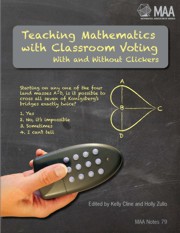Book contents
- Frontmatter
- Contents
- I An Introduction to Teaching Mathematics with Classroom Voting
- Introduction
- 1 Teaching Mathematics with Classroom Voting
- 2 Key Issues in Classroom Voting
- II Studies of Classroom Voting in Mathematics
- III Classroom Voting in Specific Mathematics Classes
- Bibliography
- About the Editors
1 - Teaching Mathematics with Classroom Voting
from I - An Introduction to Teaching Mathematics with Classroom Voting
- Frontmatter
- Contents
- I An Introduction to Teaching Mathematics with Classroom Voting
- Introduction
- 1 Teaching Mathematics with Classroom Voting
- 2 Key Issues in Classroom Voting
- II Studies of Classroom Voting in Mathematics
- III Classroom Voting in Specific Mathematics Classes
- Bibliography
- About the Editors
Summary
What is classroom voting?
Classroom voting is a powerful new pedagogy that has developed an impressive record of success in mathematics, the sciences, and engineering. In this teaching technique, the instructor poses a multiple-choice question to the class, then gives them a few minutes to work through the question and discuss it in small groups before each student votes on the correct answer, either using a hand-held electronic “clicker,” by a show of hands, or by raising a colored index card (A = red, B = blue, etc.). After the vote, the instructor goes around the class, asking students to explain their vote. The vote gives the instructor immediate feedback as to the state of the students' understanding from each individual in the class. More importantly, the vote requires every single student to play an active role, to grapple with some mathematical issue, to discuss it in a small group, and to register an opinion.
Education research shows that classroom voting and other teaching techniques which require students to actively engage in the material during class produce substantial improvements in student comprehension and retention of the concepts when compared to presentation methods that allow themajority of the students to remain as passive observers who are simply taking notes (see, e.g., [11, 19]).
History and Evidence of Effectiveness
The pedagogy of classroom voting was developed for the physics classroom by Harvard University's Eric Mazur in his influential book Peer Instruction: A User's Manual [15].
- Type
- Chapter
- Information
- Teaching Mathematics with Classroom VotingWith and Without Clickers, pp. 5 - 8Publisher: Mathematical Association of AmericaPrint publication year: 2011



